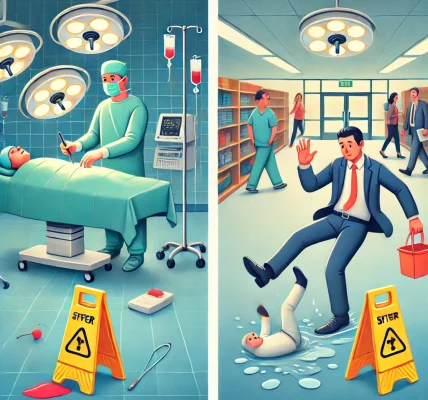A personal injury lawsuit can be a complex and lengthy process, but understanding what to expect can help you navigate it with confidence. If you or a loved one has been injured due to someone else’s negligence, filing a lawsuit may be necessary to secure compensation for medical bills, lost wages, and other damages. In this guide, we break down the personal injury lawsuit process step by step, so you know what to expect at each stage.
Step 1: Seeking Medical Treatment
Before anything else, it is crucial to seek immediate medical attention after an accident. Your health and well-being should be your top priority. Additionally, medical records will serve as key evidence in your case, proving the extent of your injuries and the treatment required.
Why Medical Records Are Important:
- They document the severity of injuries
- They establish a direct link between the accident and your injuries
- They provide an estimate of future medical costs
Even if you feel fine, some injuries can take days or weeks to manifest. Delaying treatment can weaken your claim.
Step 2: Hiring a Personal Injury Attorney
A qualified personal injury attorney can help protect your rights and maximize your compensation. They will assess your case, explain legal options, and handle negotiations with insurance companies.
Key Benefits of Hiring an Attorney:
- Legal expertise and experience with similar cases
- Negotiation skills to handle insurance companies
- No upfront costs (most work on a contingency fee basis)
Step 3: Investigation and Gathering Evidence
Your attorney will conduct a thorough investigation of your case, gathering evidence to support your claim. This may include:
- Accident reports (police reports, workplace incident reports, etc.)
- Medical records and bills
- Witness statements
- Photographs and videos of the accident scene
- Expert testimony (medical professionals, accident reconstruction specialists, etc.)
The stronger the evidence, the better your chances of receiving fair compensation.
Step 4: Filing the Personal Injury Lawsuit
If negotiations with the insurance company fail, your attorney may file a formal lawsuit in civil court. This step officially initiates the legal process and puts the defendant on notice.
Key Documents Filed:
- Complaint: A legal document outlining your case, including the allegations and damages sought.
- Summons: A court order requiring the defendant to respond.
Once filed, the defendant typically has 30 days to respond.
Step 5: The Discovery Phase
The discovery phase is where both parties exchange evidence and gather information to build their cases. This can take several months and may include:
- Interrogatories: Written questions that each party must answer under oath
- Depositions: Sworn testimony from witnesses, experts, and involved parties
- Requests for documents: Medical records, accident reports, employment records, etc.
This phase is critical, as it allows both sides to assess the strength of their case and explore settlement options.
Step 6: Pre-Trial Motions and Settlement Negotiations
At this stage, both sides may attempt to settle the case before going to trial. Settlement negotiations often involve mediation or arbitration, where a neutral third party helps facilitate an agreement.
Why Many Cases Settle Before Trial:
- Avoids the cost and time of a court trial
- Provides quicker compensation
- Eliminates the uncertainty of a jury verdict
If a fair settlement is reached, the case ends here. If not, it proceeds to trial.
Step 7: Going to Trial
If settlement negotiations fail, the case will go to trial. A judge or jury will hear the arguments, review the evidence, and make a final ruling.
What Happens During a Trial?
- Opening statements: Each side presents an overview of their case
- Presentation of evidence: Witnesses testify, and documents are introduced
- Closing arguments: Attorneys summarize their positions
- Jury deliberation and verdict: The jury (or judge) decides the case outcome
Trials can take anywhere from a few days to several weeks, depending on the complexity of the case.
Step 8: Receiving Compensation
If you win your case, the court will award compensation for damages, which may include:
- Medical expenses (past and future)
- Lost wages and loss of earning capacity
- Pain and suffering
- Property damage
The defendant may choose to appeal the verdict, which can prolong the process. If no appeal is filed, the awarded compensation will be paid as a lump sum or in structured payments.
Step 9: Post-Trial Motions and Appeals
If the losing party believes there were legal errors during the trial, they may file an appeal. This can extend the case for months or even years.
Common Post-Trial Motions:
- Motion for a new trial: Requesting the court to overturn the verdict
- Appeal: Taking the case to a higher court for review
Appeals are complex and require legal expertise to navigate successfully.
Conclusion: Patience and Legal Guidance Are Key
A personal injury lawsuit is a step-by-step process that requires patience and strategic legal guidance. While many cases settle before trial, it’s essential to be prepared for each phase of the lawsuit.
Key Takeaways:
✅ Seek medical attention immediately ✅ Hire an experienced personal injury attorney ✅ Gather strong evidence to support your claim ✅ Be patient during the legal process ✅ Understand that settlements are common but not guaranteed
If you’ve been injured due to someone else’s negligence, consulting with a personal injury lawyer can help you get the compensation you deserve. Knowing what to expect will prepare you for the journey ahead.




